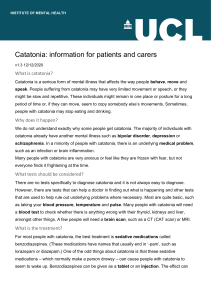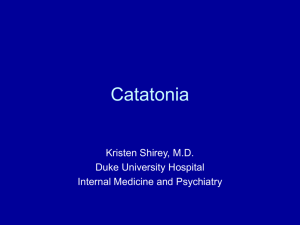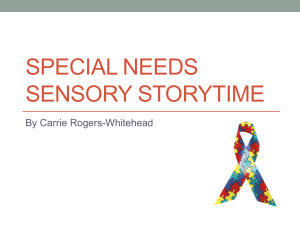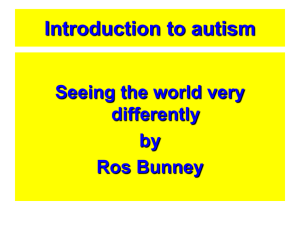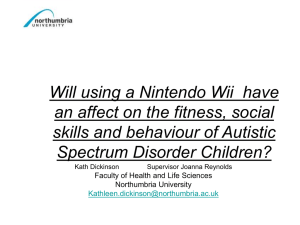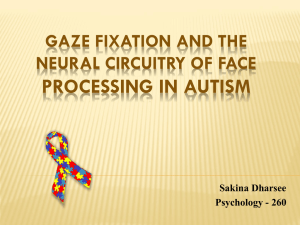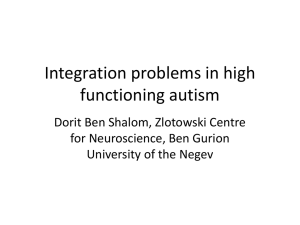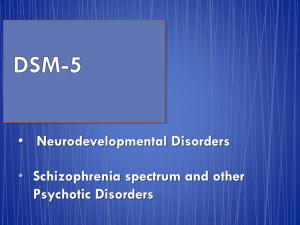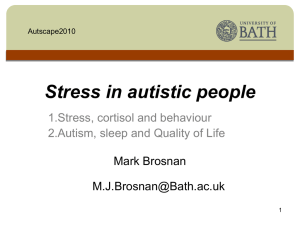Development of the Autistic Catatonia Questionnaire
advertisement
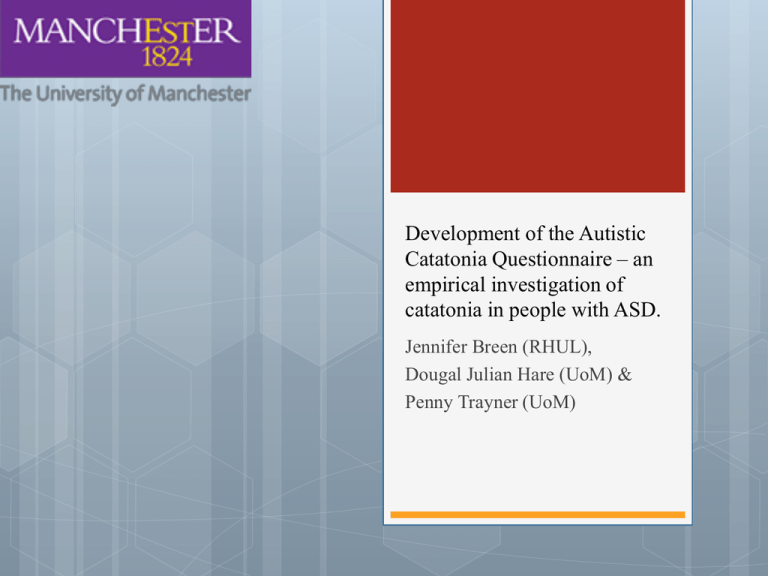
Development of the Autistic Catatonia Questionnaire – an empirical investigation of catatonia in people with ASD. Jennifer Breen (RHUL), Dougal Julian Hare (UoM) & Penny Trayner (UoM) Revision of DSM- V means that sensory and motor features now central to the presentation of ASD DSM-V Catatonia describes a cluster of abnormalities in speech, movement and behaviour, characterised by the presence of at least three of the following: Catalepsy Waxy flexibility Stupor Sgitation Mutism Negativism Posturing Mannerisms Stereotypies Grimacing Echolalia Echopraxia. Increasing recognition that catatonia presents as a co-morbid syndrome in ASD in 12–18 % of young people with ASD Insidious onset between 10 to 19 years – initial presentation of isolated symptoms with progression to full catatonic syndrome (Wing & Shah 2000). Diagnosis of catatonia in ASD complicated by the overlap in symptoms e.g. mutism, echolalia, stereotyped/repetitive behaviours Are catatonic symptoms in ASD are akin to catatonic states associated with other conditions ? “Autistic catatonia” not a co-morbid condition but extreme manifestation of ASD in a subgroup of this population (Hare and Malone 2004). Specific criteria to define what has been termed ‘autistic catatonia’ or ‘catatonia-like deterioration ’: increased slowness affecting movement and verbal responses, difficulty in initiating and completing actions, I increased reliance on physical or verbal prompting from others, increased passivity apparent lack of motivation Wing & Shah 2000; Hare & Malone 2004: Wing 2005 Given phenomenological overlap, key indicators of autistic catatonia are the emergence of new symptoms / change in the pattern of pre-existing symptoms. Autistic catatonia is challenging to treat and symptoms may persist over many years. Published treatment guidelines propose that psychological approaches, high doses of lorazepam and bilateral ECT are the current treatments of choice (Dhossche et al. 2006; Fink et al. 2006). Recent systematic review (DeJong, Hare & Bunton 2014) of 22 papers (N=28 cases) indicated that the evidence for the efficacy or effectiveness of such interventions is extremely limited given the low quality of most reports Interventions were frequently only partially described and outcome reporting relied heavily on clinician impressions, rather than objective measures of change. ECT and high dose lorazepam may have some acute partial effect on catatonic symptoms in ASD. Long-term maintenance of any improvement seemed reliant on either maintenance ECT or continued medication. Behavioural treatments show some positive outcomes in relation to symptom reduction, although no case had complete resolution of symptoms. Behavioural treatments are comprised of several components and unclear which elements are needed for change. Following all types of treatment, patients may continue to display catatonic symptoms and are unlikely to return to baseline levels of function. There is some indication that early intervention may be beneficial. Developing ASD-specific measures of catatonic symptoms Although accurate measurement of presenting symptoms is crucial for evidence-based intervention and research, limited options for clinical assessment tools for IDD populations. Many extant measures are un-validated Practical issues associated with importing catatonia rating scales to IDD (Carroll et al., 2008; Heckers et al., 2010): Affective alterations that are difficult to accurately identify via third party measures Altered speech or tone of voice that may be abnormal/ absent in IDD Non-typical movement in neurotypical populations = typical noncatatonic presentation in ASD (e.g. repetitive stereotyped movements). Present study aimed to empirically investigate the phenomenon of ‘autistic catatonia’ in children and adolescents with ASD to: Develop a valid and reliable clinical measure which can be used for assessment, research and to monitor the progression of the condition and the effectiveness of interventions. Investigate the prevalence of catatonic symptoms in young people with ASD. Develop better theoretical understanding of autistic catatonia. Present study – development of the ACQ 34-item Autistic Catatonia Questionnaire (ACQ) was developed from extant reports of autistic catatonia: 6 core features of autistic catatonia 28 supplementary items covering repetitive, motoric and sensory functioning. ACQ items scored for presence, frequency and severity. A main caregiver or parent completed the ACQ together the Repetitive Behaviour Questionnaire (RBQ) (Moss, Oliver, Arron, Burbidge & Berg, 2009) and the Carer Supplement to the Glasgow Depression Scale for People with Learning Disability (GDS-CS) (Cuthill, Espie & Cooper, 2003) Parents and carers of individuals with ASD were recruited via UK charities and support organisations ACQ developed via an iterative process: List of reported symptoms extracted from a literature review and the following excluded: ‘Singleton’ symptom s e.g. finger tapping, diaphoresis) Symptom associated with ASD (e.g. echolalia) and that did show change to the individual’s previous presentation Any symptom considered vague or speculative (e.g. auditory hallucinations, anxiety, visual hallucinations) Any item on the GDS-CS, RBQ or Sensory Behaviour Scale (Harrison & Hare 2004) N=8 reported symptoms thus excluded from the measure The conceptual structure of extant non-ASD measures of catatonia was replicated as appropriate (Northoff et al. 1999). ACQ comprises 34 items categorised into motor symptoms (n=15), affective alterations (n=5) and behavioural alterations (n=14) Each ASQ symptom is clearly defined with most having specific examples and descriptors (Carrol et al. 2008). All participants indicated that they were reporting symptoms presenting in a young person with an existing diagnosis of ASD. 41.6% reported additional diagnoses in addition to ASD - 77 different co-morbid diagnoses (excluding autistic catatonia). N=20 (14♂/6 ♀) had an existing diagnosis of autistic catatonia, nine of whom had additional diagnostic labels Not possible to complete statistical analysis for co-morbid conditions other than autistic catatonia due to small numbers of each additional diagnosis . High level of catatonic symptomatology present in current sample. All participants displayed at least four of the broad range of symptoms Eighty-four participants (85%) had displayed at least one of the core symptoms associated with autistic catatonia (ACQ items 1-6) either currently or in the past (mean=2.38, sd=1.85). Potential bimodal distribution that may indicate that autistic catatonia becomes a syndrome when core symptoms ≥ 3 ? All six of the core symptoms commonly reported in the sample Difficulty initiating movement = least frequently reported symptom (n=18) Requiring physical and/or verbal prompts = most frequently reported (n=60). 70 60 50 frequency 40 30 20 10 0 core symptom The ACQ as a clinical measure Two options for exploring the data set: Existing autistic catatonia diagnosis Presentation of autistic catatonia symptoms Problem of under-diagnosis of catatonia in ASD (Wing & Shah, 2000) means using extant diagnosis may exacerbate between-group differences An empirical approach to between-group analysis using a clinical cut-off should provide a more accurate and robust measure of autistic catatonia in the current sample. Core Autistic Catatonia Score - total number of the six core symptoms with total score summed to obtain the Core Autistic Catatonia Score [0-6] Core Severity Score – sum total of the severity of the currently presenting core symptoms [0-24] Core Frequency Score – sum total of the frequency of the currently presenting core symptoms [0-24] Core Autistic Catatonia Score Mean Core Autistic Catatonia Score for the sample =7.48 (sd=5.70; 0-24) N=15 had a Core Autistic Catatonia Score = 0 (15.2%). No significant difference in Core Autistic Catatonia Score between those with (x=9.35;sd=6.00) and those without (x=7.01, sd=5.57) extant autistic catatonia diagnosis [t(97)=1.65, p=0.10] Individuals with three or more core symptoms had significantly higher Core Autistic Catatonia Scores (x=12.04; sd=4.24) than those with less than three core symptoms (x=3.2; sd=2.86); [t(97)=12.23, p<0.01] Core Severity Score Mean Core Severity Score = 5.23 (sd=4.81; 0-23) N=22 had a Core Severity Score = 0 (22.2%). No sig. diff. in Core Severity Score between those with (x=6.95; sd=4.70) and those without (x=4.80;sd=4.77) an extant diagnosis of autistic catatonia [ t(97)=1.81, p=0.07] Individuals currently displaying three or more core symptoms had significantly higher Core Severity Score (x=8.94;sd=4.09) than those displaying less than three (x=1.75; sd=2.01) [t(97)=-11.20, p<0.01] Core Frequency Score Mean Core Frequency Score = 4.73 (sd=3.87; 0-15). N=21 had a Core Frequency Score = 0 (21.2%) Individuals with an extant diagnosis of autistic catatonia had significantly higher Core Frequency Scores (x=6.45, sd=3.90) than those without (x=4.34, sd=3.72) [ t(97)=2.24, p<0.05)] Individuals currently displaying three or more core symptoms had significantly higher Core Frequency Scores (x=7.85; sd=2.78) than those displaying less than three core symptoms (x=1.86; sd=1.93)[t(97)=-12.51, p<0.01] Total ACQ score Analysis including all 34 ACQ items on the ACQ measure (0136) yielded a mean Total ACQ Scores of 54.28 (sd=21.23; 5110) No statistically significant difference between those with (x=59.33, sd=19.77) and those without (x=52.96, sd=21.54) an extant diagnosis of autistic catatonia [t(85)=1.14, p=0.259] Individuals currently displaying three or more core symptoms had significantly higher Total ACQ Score (x=61.04; sd=21.07) than those displaying less than three core symptoms (x=44.33; sd=22.02)[t(82)=-3.53, p<0.01] Scoring recommendation for the ACQ measure Recommended primary scoring strategy for the ACQ as a diagnostic screening tool is Core Autistic Catatonia Score. Receiver Operating Curve (ROC) analysis was conducted to determine the ability of Core Autistic Catatonia Score ≥ 3 to identify individuals with extant diagnoses Area under curve = 62.4% with extant diagnosis sub-group identified at significantly higher than chance probability rates (p<0.05). An alternative clinical cut-off of between 7-8 is also possible, based on a analysis of the co-ordinates of the ROC curve (sensitivity and specificity values). Age No significant different in age between those with (x=16.20,sd=4.42) and those without (x=15.55,sd=3.89) an extant diagnosis of autistic catatonia [t(96)=-0.647, p=0.519], nor between those displaying three or more (x=16.32, sd=4.57) and those displaying less than three core symptoms (x=15.10; sd=3.29)[t(96)=-1.53, p=0.130]. Caveat of skewed distribution of age within the study sample. Gender Extant diagnosis of autistic catatonia and gender were not associated [χ²(1, n=99)=0.45, p=0.501] and there were no significant differences in Independent samples t-tests reveal that there were no significant differences in Core Autistic Catatonia Score, Core Severity Score or Core Frequency Score between males and females in the sample Core ASQ symptoms and existing diagnoses of autistic catatonia The presentation of the six core ASQ symptoms in people with extant diagnoses of autistic catatonia (N=20) was examined No clear pattern could be identified in the current sample 16 14 12 frequency 10 8 6 4 2 0 core symptom GDS-LD scores There was no significant difference in GDS-CS between those with (x=13.33, sd=5.02) and without (x=12.77, sd=4.17) extant diagnosis of autistic catatonia [t(85)=-0.491, p=0.625]. Individuals displaying three or more core symptoms had a significantly higher GDS-CS Score (x=12.74; sd=5.07) than those displaying less than three (x=8.43; sd=6.09)[t(85)=-3.586, p=0.01] Linear regression analysis indicated that Core Autistic Catatonia Score accounted for 15% of GDS-CS Score [r2=0.15, p<0.001] RBQ scores Mean RBQ score for the sample was 32.82 (sd=16.73; 1-68). Individuals with extant diagnoses of autistic catatonia had higher RBQ total scores (x=40.56, sd=15.73) than those without (x=30.80, sd=16.49) [t(85)=2.256, p<0.05] Individuals presenting with three or more core symptoms had RBQ total scores (x=39.58, sd=13.74) than those with less than three (x=26.20, sd=16.86)[t(85)=-4.05, p<0.01] Linear regression analysis indicated that Core Autistic Catatonia Score accounted for 12% of the variation in RBQ Total Score [r2=0.12, p<0.001] Future directions ACQ appears to be a valid measure for both research and clinical assessment of autistic catatonia Further work required to refine psychometric properties of the ACQ Ongoing study at Manchester and Birmingham Universities examining catatonic symptomatology in Tuberous Sclerosis, Fragile X, Retts and Cornelia de Lange syndromes
